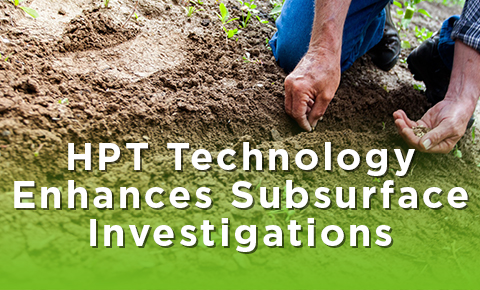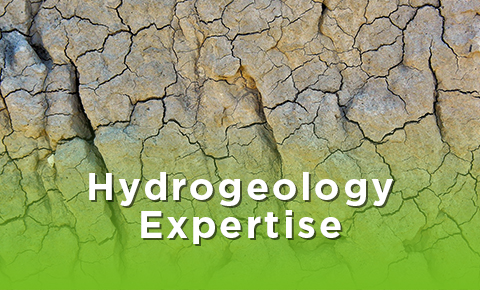Using HPT Technology to Enhance Subsurface Investigations
May 7, 2020

Understanding groundwater preferential pathways is a critical link in the development of conceptual site models and the design of groundwater remediation strategies. Identifying and mapping transmission zones that contaminants favor, or “preferential pathways,” is crucial when making decisions about how to best approach groundwater remediation at a site. Time and money can be saved by using technology to quickly gain a comprehensive picture of subsurface hydrogeologic conditions.
Hydraulic Profiling Tool (HPT) systems are an asset in gaining a detailed picture of the subsurface. Used with mobile drilling platforms, an HPT probe system can provide boring logs that make it easy to interpret subsurface soil characteristics.
Defining Compounds Found in Soil and Groundwater
VOCs (volatile organic compounds) are legally defined, but generally are organic compounds that evaporate at low temperatures, typically room temperature or below. Because of their volatility, they are more mobile than many other compounds. The USEPA and other regulatory agencies set limits for many VOCS in air, soil and water.
SVOCs (semi-volatile organic compounds) are legally defined but have lower volatility and evaporate at higher temperatures than VOCs. Because of their lower volatility, they can remain in soil or water for long periods of time and accumulate more readily than VOCs. The USEPA and other regulatory agencies set limits for many SVOS in air, soil and water.
HPT Operation and Benefits
An HPT system operates by applying water through a small opening on the side of the drilling probe as it is advanced through the subsurface. Water pressure and flow rate are monitored by the HPT logging system and displayed in real time. Sandy soils that contaminants favor and clays that affect groundwater flow are easily identified. Electrical conductivity logs can also be generated using the HPT system for an added parameter in interpreting subsurface conditions.
A Membrane Interface Probe (MIP) can operate in conjunction with an HPT, and is used to detect the presence of volatile organic compounds (VOCs) in real time and at accurate depths. An added benefit of HPT, electrical conductivity and MIP technology is their footprint. Nothing is removed from the subsurface which means investigation waste, along with the associated disposal costs, is nearly eliminated.
Case Study: Using HPT in the Field
McFadden Engineering (MEI) utilized HPT boring logs to create stratigraphic cross sections to develop a conceptual model of groundwater flow at a large site near Mobile, Alabama. A product released into soil and groundwater at an industrial facility impacted groundwater quality over many acres. MEI was retained by the client to conduct a subsurface investigation and design an effective remediation strategy.
Preliminary site assessments revealed a very complex geologic lithology. Using HPT in conjunction with discrete groundwater sampling conducted at various depths, geologists and engineers at MEI identified preferential flow pathways for contaminated groundwater at the site. This information was used to construct two remediation systems designed to intercept, capture and treat contaminated groundwater prior to interacting with surface water in the area. Recovery wells were installed at depths that coincided with preferential pathways identified using HPT to efficiently target contaminated zones.
In teaming up with our industry partners and utilizing HPT and MIP technology, MEI can bring great value to clients that need quick assessment of subsurface conditions. By identifying and targeting groundwater preferential pathways, MEI can design effective remedial options tailored to specific site hydrogeologic and contaminant properties.
Hydrogeology Expertise: Our Approach to Site Evaluation and Remediation
May 7, 2020

Hydrogeology is the study of groundwater distribution and movement over the ground surface and through soils and rocks. At McFadden Engineering (MEI), we have a team of professional Engineers and Geologists who specialize in hydrogeology. Contaminants that reach the soil frequently become a two-part problem as both the soil and the groundwater in the soil can be affected.
Groundwater, Surface Water and Groundwater Contamination
Groundwater is water (liquid or frozen) that has seeped below the earth’s surface and is stored in the spaces between soil or rock particles. An aquifer is created when a large amount of groundwater is stored in the same place. Groundwater flows through the soil or rock under the influence of gravity, usually on the order of a few inches to a few feet per year. Surface water is water (liquid or frozen) located above the surface of the ground, including stormwater runoff, streams, creeks, rivers, glaciers, ponds, lakes and oceans. Surface water usually flows more quickly than groundwater.
Soil and groundwater contamination impacts the public and the environment in many ways:
- It can affect drinking water quality and can lead to health maladies associated with drinking contaminated water.
- Contamination can devalue property and limit future uses for that property.
- When buildings or residences are built on top of contaminated soil there may be a danger of vapors traveling up through foundations and into the air inside, where people may breathe in toxic compounds.
- Natural habitats for wildlife may be lost in areas with contaminated soil and groundwater. This is particularly true for aquatic habitats.
Site Evaluation and Remediation Approach
When it comes to our hydrogeology expertise and working with clients, we evaluate the entire site including the soil, the groundwater, and the surface water to determine the extent of the problem our clients might be facing. In addition, we also hold expertise in EPA standards and compliance regulations; software such as SW2 help us understand the issues faced by different construction projects, and knowing how to read epa swmm helps us turn data into actionable insights.
When it comes to site solutions, remediating the soil is usually the easiest option. If the area can be excavated, removing the impacted soil and disposing of the material is typically the quickest and cheapest option. However, when contamination is under a building or other structure, or it reaches the groundwater in the soil, the situation is often more complex. Furthermore, regulatory agencies are more sensitive to groundwater issues because groundwater is mobile and can travel off-site.
To tackle these challenges, we construct subsurface cross-sections and use groundwater modeling to develop hydraulic flow models for sites. These models help us predict groundwater flow direction and velocity, and indicate the best place to attack the issue with remediation systems. Using these tools and our experience in dealing with these issues, we can develop a cost-effective approach to cleaning up the site while meeting the regulatory requirements that may be present.
Timeline for Cleanup
Many variables can play a part in the timeframe for cleanup work. These can include:
- Cost of remediating a site and how much funding is available to spend to solve the problem.
- The chemical/physical nature of the contaminating chemical(s). For example, if the chemical dissolves easily in groundwater, it is easier to deal with than a chemical that separates itself from water (think oil/water).
- The concentrations of the contaminants in soil or groundwater will affect how long it takes to remove them or break them down.
- The response of time of state regulators is a big factor. It can take months to get approval from ADEM or another state’s regulatory agency to proceed with a remediation plan.
Best Management Practices
McFadden Engineering also specializes in designing Best Management Practices (BMPs) required at many sites. BMPs help minimize runoff that can ultimately allow contaminants to enter the surface water and groundwater. We can help keep clients in compliance by designing a Best Management Practices program, obtaining the necessary permits, and performing the required monitoring to help maintain compliance.
Our team has the personnel, tools and experience needed to help you develop a solution to solve your on-site challenges. If you have questions or are looking for project assistance, contact our team.